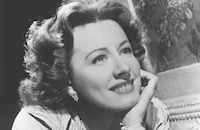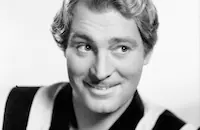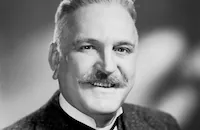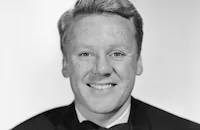The White Cliffs of Dover

Brief Synopsis
Cast & Crew
Clarence Brown
Irene Dunne
Alan Marshal
Roddy Mcdowall
Frank Morgan
Van Johnson
Film Details
Technical Specs

Synopsis
As she prepares for an influx of wounded soldiers at a London military hospital, American-born Red Cross volunteer Lady Susan Ashwood worries about her son John, who is fighting overseas, and fondly recalls her arrival in England many years before: In April 1914, Susan and her father, Hiram Porter Dunn, a small-town newspaper publisher from Rhode Island, arrive in London for a two-week vacation. Hiram detests everything English, especially the rainy weather, which quickly aggravates his lumbago and keeps him in his boardinghouse bed. On their last day in London, Col. Walter Forsythe, an elderly boardinghouse resident, invites Susan to accompany him to a ball hosted by the Duke and Duchess of Waverly, and she eagerly accepts. At the ball, the colonel tricks young Sir John Ashwood into dancing with Susan by leading him to believe she is his friend's Australian cousin, whom John has been asked to entertain. John is immediately taken with the down-to-earth Susan and spends a long, romantic evening with her. Just before parting, John begs Susan to stay in England, but she tearfully insists that she has to leave with her father. The next morning, however, John shows up at the boardinghouse and announces that his mother, Lady Jean, has invited both Susan and Hiram to their country manor. After much cajoling, Hiram finally gives Susan permission to stay in England without him, and she is whisked away to the country.
Although they give Susan a warm welcome, John's family, including his brother Reggie, is unsure about her relationship with John and one night invite his childhood sweetheart, Helen Hampton, who is still in love with him, to dinner. John, however, is sure about his feelings for Susan and proposes, but she is too stunned to give an immediate answer. Susan then receives a telegram from her father, pleading with her to come home, and when John's family makes seemingly anti-American comments in front of her, she explodes in anger. Although Lady Jean apologizes and assures her that the English are reserved by nature, Susan prepares to sail home, convinced that she is too "American" for John. As she is about to board the ship, however, John appears and talks her into marrying him. In the midst of their honeymoon, war breaks out, and John, who, following family tradition as an Army officer, is sent off to fight.
After three years of separation, Susan and Lady Jean learn that the government has arranged for soldiers' wives to be reunited with their husbands for a brief leave in France. Their joy is shortlived, however, when a telegram announcing Reggie's death in battle also arrives. At an elegant resort in coastal France, Susan and the war-weary John relish every moment of their reunion. A year later, Susan, who now lives in London, watches hopefully with her newborn son, John Ashwood II, as American troops march through the streets. Just before peace is declared, however, John is killed in action, and Susan is devastated. Lady Jean finally brings Susan out of her embittered grief by impressing on her that John sacrificed his life in order to assure his son a peaceful future.
Many years later, Susan and Hiram, who now lives at the Ashwood manor, become concerned when they hear German acquaintances of young John predicting that Germany will soon "finish" the business of the previous war. Sure that another war is coming, Hiram convinces Susan to return to America with John, but while they are on the train to the coast, John, who takes seriously his duties as master of the manor, persuades her to stay in England, his home. When war finally breaks out, both John and his childhood sweetheart, farmer's daughter Betsy Kenney, go to the front. Back at the hospital, Susan's reveries are interrupted by the arrival of the wounded soldiers. As she had feared, John is among the injured and has only a few hours to live. When she sees American troops outside, marching side by side with English soldiers, however, she assures John that his sacrifice, like that of his father, will not be in vain.

Director

Clarence Brown
Cast

Irene Dunne

Alan Marshal

Roddy Mcdowall

Frank Morgan

Van Johnson

C. Aubrey Smith

Dame May Whitty

Gladys Cooper

Peter Lawford
John Warburton
Jill Esmond
Brenda Forbes
Norma Varden

Elizabeth Taylor
June Lockhart

Charles Irwin
Jean Prescott

Tom Drake

Isobel Elsom
Edmund Breon

Miles Mander
Anne Curson
Steven Muller
Norbert Muller

Molly Lamont
Lumsden Hare

Arthur Shields
Emily Fitzroy
Emily Massey
Clifford Brooke
Guy D'ennery

Doris Lloyd
Lal Chand Mehra
Larry Wheat
Matthew Boulton
Ethel Griffies
Elton Burkett
Eldon Burkett
Herbert Evans
Keith Hitchcock
Vera Graaff
Anita Bolster
John Rogers

Ian Wolfe
Gerald Hamer
Douglas Grant
Alec Craig
Clyde Cook
Gavin Muir
Charles Coleman
Arthur Gould-porter
Vernon Downing
James Menzies
Kay Deslys
Edgar Licho
Adrienne D'ambricourt
George Davis
Leo Mostovoy
J. Patrick O'malley
George Kirby
Wilson Benge
Ottola Nesmith
Joy Harrington
Harry Allen
Bobby Callahan
Nelson Leigh
Mabel Row
Crew
Clarence Brown
Jack Dawn
Randall Duell
George Folsey
Sidney Franklin
George Froeschel
Cedric Gibbons
Arnold Gillespie
Irene
Al Jennings
Robert J. Kern
Jan Lustig
Jacques Mersereau
Robert Nathan
Warren Newcombe
Robert Planck
Major Cyrl Seys Ramsay-hill
Douglas Shearer
Lou Smith
Gile Steele
Herbert Stothart
Claudine West
Edwin B. Willis

Videos
Movie Clip



Trailer
Film Details
Technical Specs

Award Nominations
Best Cinematography
Articles
The White Cliffs of Dover
MGM studio chief Louis B. Mayer, an Anglophile himself, had been delighted by the huge success of Mrs. Miniver (1942), which won seven Academy Awards, including Best Picture, Director and Actress. He wanted another paean to the indomitable British spirit, so when producer Sidney Franklin read The White Cliffs of Dover, he thought it could equal the success of Mrs. Miniver, and took it to Mayer. Franklin had been one of MGM's top directors up to the time of Irving Thalberg's death after which he moved into managing the studio's prestige projects. Both as director and producer, Franklin had an affinity for British-themed films, like Noel Coward's Private Lives (1931), The Barretts of Wimpole Street (1934), and Waterloo Bridge (1940).
Franklin and Director Clarence Brown had both worked in films for about 30 years, and were very close friends, but had not worked together until The White Cliffs of Dover. Brown was one of MGM's most accomplished visual stylists, and known for his ability to win the trust of the studio's top divas, Garbo, Shearer and Crawford. The White Cliffs of Dover, with additional stanzas by poet and novelist Robert Nathan (Portrait of Jennie, 1948), top talents like Franklin and Brown behind the camera, and the classy and elegant Irene Dunne in front of it, was obviously slated to be one of 1944's most prestigious films.
The production was not easy for Dunne. She had been working on A Guy Named Joe (1943), but co-star Van Johnson was injured in an accident, and that film was put on hold until he recovered. So Dunne began working on The White Cliffs of Dover, but Johnson's recovery was quicker than anticipated, and she ended up working on both films simultaneously. Van Johnson, in fact, has a supporting role in The White Cliffs of Dover as Dunne's American suitor.
Also in supporting roles are Roddy McDowall as Dunne's sixteen-year-old son, John, and Peter Lawford, who plays him at the age of twenty-four. In a small part as McDowall's childhood sweetheart is a very young Elizabeth Taylor. It was her fourth film role, just prior to her breakout performance in National Velvet (1944), also directed by Clarence Brown. Taylor's grown-up counterpart is played by June Lockhart.
Some critics felt that The White Cliffs of Dover was too fawning toward all things English. "This sterling-silver picture...is such a tribute to English gentility as only an American studio would dare to make," sneered Bosley Crowther in the New York Times. "Like drinking tepid orange pekoe at a rained-out garden party staged by some deep-provincial local of the English-speaking Union," sniffed James Agee. But there was also praise for the excellent performances, superb production values, and the sincerity of its wartime message. Philip Hartung wrote in Commonweal, "The film does succeed in spite of its confused satire and outmoded attitudes, in pointing up a moral: that the English and Americans cannot break faith with their dead again; they must build together for a permanent peace." And The White Cliffs of Dover did have resonance for a war-weary public. Though not the blockbuster that Mrs. Miniver had been, it did very well at the box office both in the U.S. and Great Britain.
Director: Clarence Brown
Producer: Sidney Franklin
Screenplay: Claudine West, Jan Lustig, George Froeschel, based on the poem by Alice Duer Miller, additional poetry by Robert Nathan
Editor: Robert J. Kern
Cinematography: George Folsey
Costume Design: Irene
Art Direction: Cedric Gibbons, Randall Duell; Set Decoration: Edwin B. Willis, Jacques Mersereau
Music: Herbert Stothart
Principal Cast: Irene Dunne (Susan Dunn Ashwood), Alan Marshal (Sir John Ashwood), Frank Morgan (Hiram Porter Dunn), Roddy McDowall (John Ashwood II as a boy), Peter Lawford (John Ashwood II at 24), Dame May Whitty (Nanny), C. Aubrey Smith (Colonel), Gladys Cooper (Lady Jean Ashwood).
BW-127m. Closed captioning.
by Margarita Landazuri

The White Cliffs of Dover
Quotes
Such a nice young thing. Not a bit like an American.- Susan Dunn's landlady
Trivia
Notes
The working title of this film was The White Cliffs. The opening credits include the following written quotation from Alice Duer Miller's poem The White Cliffs: "I have loved England,/dearly and deeply,/Since that first morning,/shining and pure,/The white cliffs of Dover, I saw rising steeply/Out of the sea that once made her secure./I had no thought then of husband or lover,/I was a traveler, the guest of a week;/Yet when they pointed 'the white cliffs of Dover,'/Startled I found there were tears on my cheek." That excerpt, as well as other excerpts from Miller's poem and poetry by Robert Nathan, written in the style of The White Cliffs, are also heard in a voice-over narration, delivered intermittently by Irene Dunne as the character "Susan Ashwood." Miller's poem became a best-seller in 1942 after actress Lynn Fontaine gave a dramatic reading of it during a radio broadcast. According to a November 1940 Hollywood Reporter news item, Ronald Colman, who owned the rights to the poem, and Bette Davis announced that they wanted to star in the screen adaptation for no money and requested that all profits go to the American and British Red Cross. According to June 1942 Hollywood Reporter news items, director Clarence Brown bought the rights to the poem from Colman and initially planned to make the film independently. Although several Hollywood studios were reportedly in negotiation with Brown for the project, Brown announced on June 8, 1942 that he was making the film in England, with British financing and stars. United Artists was set as distributor at that time. In addition, Brown announced he was considering adapting the poem first as a Broadway stage play, and would finance and direct the production himself. By June 15, 1942, however, M-G-M had purchased both the screen rights to the poem and Brown's services as director of the film.
Hollywood Reporter news items add the following information about the production: As late as December 1942, Brown was still planning to film the picture in England, but the only shots taken there were background shots of London's Piccadilly Circus and aerial shots of the Dover Cliffs, which were filmed by a British aviator. In late July 1942, Hollywood Reporter announced that Brown was contemplating launching a nationwide radio poll to find a "typical" American "boy and girl" for leading roles in the picture. Karl Freund was announced as cameraman in early May 1943, but by the time production began in late May, Robert Planck had been assigned. George Folsey, however, received onscreen credit as cameraman. Although Margaret Adden, Harold DeBecker, twins Joan and Janet Brubaker and Ronald and Harold Butterbaugh, Mary Elliott and Alex McQuoid were listed as cast members in Hollywood Reporter, their appearance in the final film has not been confirmed. Some exterior scenes were filmed at the Clarence Brown Ranch in Calabasas, CA. Proceeds from the Los Angeles opening of the film went to the volunteer Army Canteen service, according to the Hollywood Citizen-News review. The White Cliffs of Dover was announced in Hollywood Reporter as the first of three M-G-M films to be dubbed into Spanish for Latin American release, along with Bathing Beauty and Gaslight. The picture was named as the tenth most popular film of 1944 by the National Board of Review. Folsey received an Academy Award nomination in the Cinematography (Black-and-White) category. In November 1976, a benefit screening of the film was held in Hollywood, with proceeds going to the preservation and restoration of the lands and buildings along the cliffs of Dover. The song "(There'll Be Blue Birds Over) The White Cliffs of Dover," written by Nat Burton and Walter Kent and sung by popular British singer Vera Lynn, became a hit in 1942, but was not used in the film.















